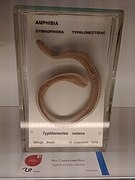Typhlonectes natans
| Typhlonectes natans | |
|---|---|

| |
| Scientific classification | |
| Domain: | Eukaryota |
| Kingdom: | Animalia |
| Phylum: | Chordata |
| Class: | Amphibia |
| Order: | Gymnophiona |
| Clade: | Apoda |
| Family: | Typhlonectidae |
| Genus: | Typhlonectes |
| Species: | T. natans
|
| Binomial name | |
| Typhlonectes natans (Fischer, 1880)
| |

| |
| Typhlonectes natans native distribution map | |
| Synonyms | |
|
Chthonerpeton haydee Roze, 1963 | |
Typhlonectes natans, also incorrectly called the rubber eel, is a species of caecilian in the family Typhlonectidae found in Colombia, Venezuela, and possibly Trinidad and Tobago. Its natural habitats are dry savanna, subtropical or tropical dry shrubland, subtropical or tropical moist shrubland, subtropical or tropical seasonally wet or flooded lowland grassland, and rivers. T. natans is commonly kept as an aquarium pet, and is sometimes sold as a "fish" in aquarium stores.
A specimen of T. natans was found in October 2019 in Miami-Dade County, Florida, making it the first caecilian to be collected in North America.[2]
They grow to 45 to 55 centimetres (18 to 22 in) in length. They are dark grey to black in color. While T. natans can and occasionally does breathe air at the surface, most of its respiration takes place through its skin.
The species is
Gallery
References
- . Retrieved 15 November 2021.
- ISSN 2332-4961.



